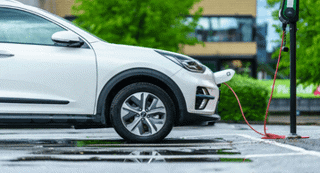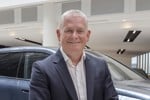The UK is on track to meet the minimum of 300,000 charge point installations by 2030, but the Government spending watchdog said there is still a regional divide with regards to the roll out.
In a new report, the National Audit Office (NAO), which holds Government spending to account, says that the Government faces challenges to address the location of charge points, their accessibility and wider barriers such as planning rules.
As of July 2024, 64,632 electric vehicle charge points had been installed.
This is in line with projections made by the Department for Transport (DfT), through the Office for Zero Emissions Vehicles (OZEV), a team working across the Government supporting the transition away from petrol and diesel.
DfT anticipates that its local charge point programme and continued growth in private installations will support the trajectory needed to reach 300,000 by 2030.
While the overall number of charge point installations is on track, the estimate does not account for where charge points should be installed.
This has created a regional divide; with 44% of public charge points in the UK have been installed in London and the South East, while only 15% of charge points in England are in rural areas.
London has more charge points installed per capita than any other region.
Not enough rapid chargers on A-roads
The location of charge points is also an issue along the strategic road network: motorways and major A-roads.
Whilst the number of rapid and ultra-rapid charge points installed along the strategic road network has exceeded DfT’s expectations, the NAO said there are still stretches of A-roads which don’t have sufficient charge points.
In 2020, the Government announced an aim for six ultra-rapid charge points at every motorway service area in England by 2023, anticipating that the private sector would be able to achieve this.
As of July 2024, 62% of service areas have met this.
The NAO report said the UK’s charge point rollout is being hindered because it is "slower and more expensive than it needs to be for charge point operators to get planning permissions and electricity grid connections".
In response, Government is working with stakeholders to streamline planning and connection processes where possible, and is considering more fundamental reform, including looking at rules around highway consents and gaining landowner permissions for development.
Consumers have numerous concerns over using public charge points, which Government has put in place regulation to address.
These concerns include complexity in using charge points, with operators having different ways to pay; pricing being unclear or unduly expensive; and malfunctioning or inoperative charge points.
It is still too early to say whether OZEV’s regulatory intervention has helped, as many of its requirements only came into force from November 2024.
Another section of the report shows that local authorities are on track to install 100,000 charge points, but the scheme put in place to assist councils with their charging infrastructure plans is facing major delays.
Drivers with disabilities left behind
The NAO said drivers with disabilities have been left behind in the rollout to date; many charge points – and their surrounding environments – have features that make them inaccessible.
These include charge points placed on kerbs, with nearby obstructions, or those closely spaced together, presenting difficulties for wheelchair users.
DfT said in its 2018 inclusive transport strategy that the Equality Act 2010 was applicable to the provision of charge points, and co-sponsored the creation of a standard which specifies minimum requirements for charge point accessibility.
However, industry and local authorities have reported further clarity is needed on compliance with this standard and DfT has established a technical group to address these issues.
Gareth Davies, head of the NAO, said: "Government’s estimate of the 300,000 public electric vehicle charge points needed by 2030 appears achievable, although there is more to do to ensure adequate coverage in all parts of the country.
"Government is using regulation to improve the user experience of public charge points and needs to address access for people with disabilities.”
Edmund King, AA president, said it was great to see progress on what is an important infrastructure challenge for the future of EVs in the UK.
However, he added: "The AA believes it is vital that communities are not left behind, and the NAO is right to point out that Northern and rural areas are not seeing installations at the same rate as the South.
"Similarly, we must ensure that the major A-road network can provide regular charging points.
“To provide confidence to drivers now and in the future, it is crucial that all road users, including those with mobility issues, can use public chargers easily.
"That means ensuring step-free access to the charger, plugs and cables which are light enough for people to use and, vitally, ease of payment.
"We are optimistic that the charge point operators, DfT, local authorities and communities can continue their positive work and reach the 2030 target.”
Geoffrey Clifton-Brown MP, chair of the Committee of Public Accounts, said that while good progress has been made on the rollout of public charging points for EVs, issues with planning permissions are acting as roadblocks to further progress.
He added: “If the Government is serious about encouraging the take-up of electric vehicles, it must ensure the public can reach reliable, convenient and accessible charging points.”
























martinwinlow - 13/12/2024 13:09
Planning consent is (surely?!) completely irrelevant - we are talking about an existing car-park-type scenario in the middle of a huge motorway service area, here, not 'green-field location in an area of ONB, for crying out loud!! And grid connection issues simply are not issues any more with the price of stationary battery storage as low as it now is. For the majority (if not every singe one) of MSAs that have not yet got comprehensive rapid DC EV charging facilities already (ie at least 6 if not more) and that are using the excuse that they can't get a good enough grid connection, installing a large battery and 'trickle-charging' it from an existing grid connection (let alone the possibility of a sizeable contribution from adjacent renewables ie on-site wind turbine and/or PV all over the roof) would cost *far less* than an equivalent grid connection. In short, the slackers are just being very wet - or simply don't believe in sustainable transport transition and should therefore be *compelled* to change their attitude or face being forced out of business.